It was a warm, Sunday afternoon in Lanzarote and we were on the hunt for a pay phone. Armed with a few pesetas (the Euro was yet to arrive), we hurried down the beach, nervous that we might miss our special Sunday night call.
Hastily pushing the coins into the phone, we dialled the number scrawled on a napkin and waited for the distant ring that would connect us to the Buckinghamshire cottage. “Hi Grandma!” we shouted as the retriever clicked, “we’re calling you from the beach!” A laugh filled the line and we heard our Grandma’s soft Lancashire voice reply a few seconds later: “How’s the holiday, girls?”
Frantically trying to cram in a round up of our week away – grabbing the phone off one another intermittently – we listened as our Grandma described the recent frost that had descended on England. Feeling a world away from her frosty English garden, we clung to the pay phone, making the most of every second before the money ran out.
The fact that I remember this conversation so vividly almost 19 years on, is something I’ve often wondered about. Struggling to remember any specific Whatsapp conversations I’ve had in the last four years, or rushed mobile phone conversations as I race for a train, why is it that I remember this phone call home so clearly? And why is it a memory that I look back on with so much happiness?
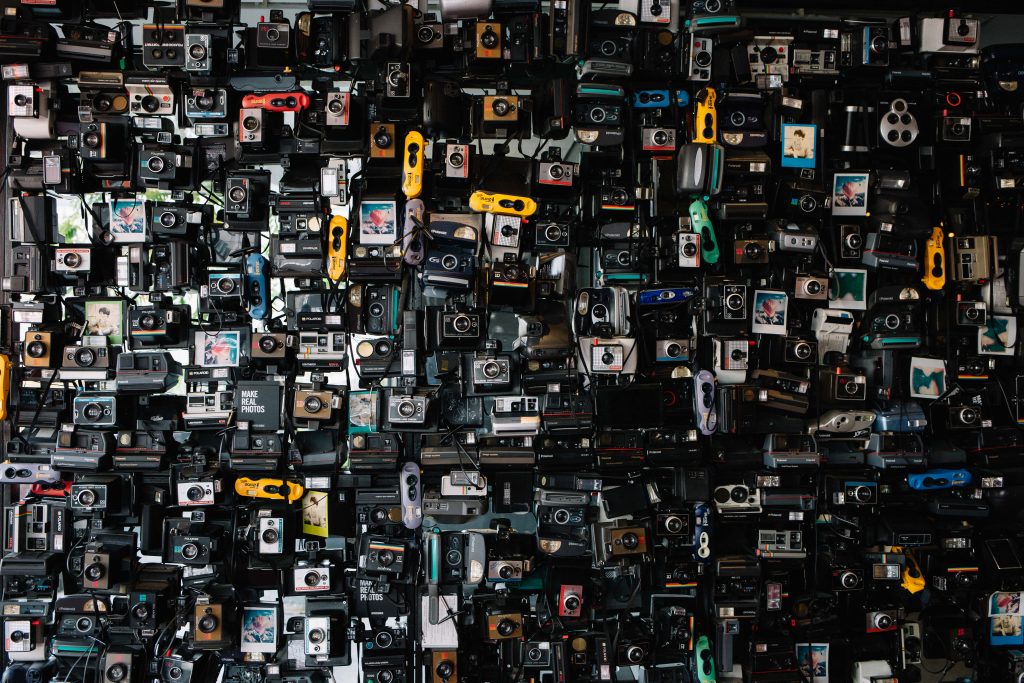
On reflection, our family holiday to Lanzarote was the last trip I took without a mobile phone. The last holiday in which to ‘go on holiday’ meant to truly disappear off grid. On such long-forgotten vacations, there were no expectations to call, text or send a £5 photo message. In fact, Lanzarote 1999 was the last time I travelled – you might argue – freely. Sure, I wanted my friends to see the pink inflatable flamingo I’d bought, but I had my trusty disposable camera for that: my holiday photos could be shared once I was home.
Fast forward to 2018 and I exist in an altogether different world. A world that my 13-year old, pay phone-seeking self, would struggle to comprehend. You see, in 2018, pay phones have become sinister, graffiti-riddled dens and even more surreally, a photo sharing app called Instagram has allowed me to travel the world. In the words of my young self: “that’s bonkers” (I was an innocent child).
Today, travel is no longer an annual two-week escape from reality, during which all ties with home are severed. Instead, travel is now an experience Laura and I share with a community of over 60,000 on an almost hourly basis. From the moment we land in a new destination, our job is to share our travel experiences in real-time. Indeed, with our online and offline lives now increasingly blurred, this new way of travel was one I’d begun to almost unconsciously accept – until an intriguing invite landed in our inbox, that is.
‘We’d like to welcome you to Vienna!’ the emailed read, ‘to enjoy the city without the hashtag.’ Curious, I read on as the email from the Vienna Tourist Board detailed an unexpected campaign. Encouraging its visitors to ‘see the city, not # the city,’ we would be challenged to spend three days exploring the Austrian capital without sharing any of it online. An arguably bold move on the part of the tourism board, this contrary campaign, titled ‘Unhastag Vienna‘, was inviting us to explore the city with just the use of a LOMO instant camera.
Genius.
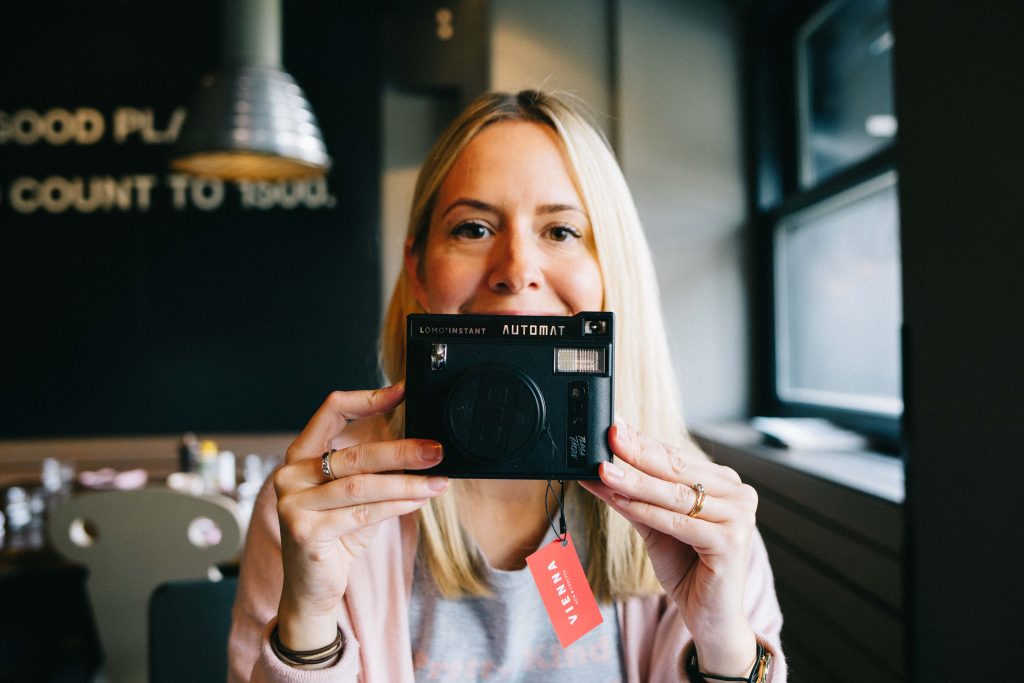
Reaching (ironically) for my phone having read the email, I scrolled through the photos I’d taken that day whilst exploring LA. Counting upwards of 60 photos – many of the images replicas of one another – I then turned to the ‘screen time’ feature recently introduced to the iPhone. This made for even more unsettling reading. According to my phone, I had spent a total of 3 hours and 45 minutes on Instagram that day and a whopping 7 hours on my phone in total. How was that even possible? I felt slightly nauseated.
These startling statistics and mindless photographs propelled me into urgent action. Typing a speedy reply, I confirmed that we’d be delighted to enjoy a digital detox in Vienna in just a few weeks time. If my screen time data was anything to go by, I was in desperate need of it.
That night, as we left for dinner along the star-lined boulevard of Hollywood, we left our phones behind; the email’s sentiment settling uncomfortably under our skin.
Our time exploring Vienna without the use of social media was as memorable and thought-provoking as we’d hoped. Unexpectedly testing at times, our three days offline in this beautiful city helped us to truly reevaluate the way in which we travel. Below, we’ve compiled five lessons that we learned during our digital detox: teachings that we hope to carry forward on future adventures.
1) The world can wait
In a world in which a postcard once took several weeks to arrive home (if at all), travel experiences can today be shared instantly. With 8.95 million photos or videos shared to Instagram every single day (a fact that made me slightly light headed), it seems that the world is in the midst of an irresistible social media epidemic. Indeed, as the old adage goes: if you didn’t post it, did it really happen?
Upon arriving in Vienna, we raced to our hotel room in the 25hours Hotel, where we discovered that we’d been strategically placed in their ‘Analogue Room’. A retro paradise free of mod-cons, we discovered the room was instead filled with objects from our childhood: including a small aerial TV, VCR, record player and type writer. My first reaction to the room, however, was not to jump on the bed to enjoy Titanic on VCR, but to instead reach for my phone.
“People are going to love this,” I said, absentmindedly taking photos of the room. But instead of joining in, Laura’s expression turned from happiness to pure terror, as she dramatically snatched the phone from my hands. Realising that I’d lasted approximately 30 seconds before failing at my digital detox, I sat shamefully on the bed and fiddled with my nails. Who was I meant to share this experience with now?
This uncomfortable desire to share my travel experiences with anyone other than my actual travel companion (Laura), continued. Visiting the city’s famed Cafe Central, my Apfelstrudel just didn’t seem so exciting now that I couldn’t share it with my Mum via Facebook. And later, the Christmas decorations that hung so gracefully from Vienna’s handsome streets seemed just that little bit less sparkly, without my favourite Instagram filter.
However, as the trip went on, my twitchy thumb softened and my anxious impulse to continually upload boomerangs, rewinds and pretty images began to settle. I was going cold-turkey and despite feeling slightly sweaty, it appeared to be working. I was kicking the habit.
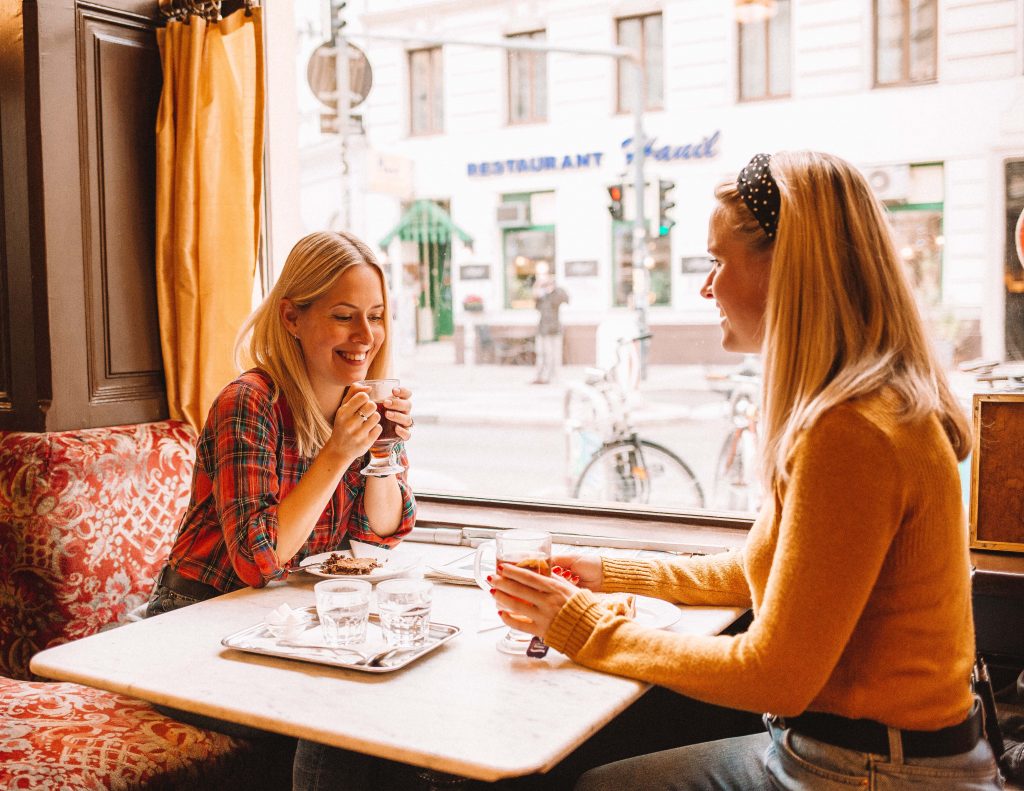
Settling into two seats in one of Vienna’s most famous coffee houses, we sipped hot chocolate and watched passersby. An apt sign on the counter read: ‘no mobile phones’ and we relaxed into each other’s company: even managing to hold eye contact from time to time. With no tense talk of whether we’d covered everything we needed to on social media that day, we found there was nothing more to do than hold a conversation Remarkable. Excitedly unfolding a city map – using a pen to mark our afternoon’s designated sights – there was a strange thrill to living offline. We felt, well, free.
In retrospect, although we’ve travelled the world together, Vienna was the first trip with Laura where I felt we’d left with a shared, personal experience. Creating travel memories that no one else can access or document, made our trip seem somehow more special. For the first time in a long time, we took the time to truly appreciate each other’s company, away from the distractions of likes, pings or urgent inbox messages.
As we came to realise over our time in Vienna, the (perhaps disappointing) truth is that the world will merrily continue to spin without your daily Facebook updates or Instagram stories. In fact, aside from your loyal parental followers, it’s unlikely anyone will even notice your absence. Of course, sharing travel experiences with others is a satisfying experience – we’re sociable beings after all – but nothing will replace those private memories you create with your travel companion.
2) Viewing life through a screen dulls the experience
As the tram pulled away, I observed my fellow passengers in our cosy carriage. Heads down, I counted that 18 of the 20 people on the tram (one being an infant) were absorbed in their glowing handsets. Although a common scene nowadays, I felt unexpectedly sad as I looked around me. The tram was trundling past beautiful Viennese architecture and my fellow passengers appeared oblivious to what they were missing.
With no distractions, I peered out the window: a peculiar feeling that the usual barrier between me and the rest of the world had been lifted. Not too dissimilar to the day that I was finally given contact lenses, I felt like the world had suddenly become that little bit more brighter, more detailed. There’s no doubt that was I carrying my phone on me in that moment, my journey on the tram would have been much different. My focus would instead be on recording a steady video of the city’s streets; an exercise that would have robbed me of the journey’s smaller, finer details.
My creeping suspicion that mobile phones create a barrier between us and the ‘real’ world was confirmed when we visited the crowning glory of the Unhastag Vienna Campaign , at the beautiful Belvedere Palace.
Climbing the sweeping staircase of the Palace, our guide glanced at us excitedly. Instructed to simply visit the painting ‘The Kiss’, we anxiously rounded the corner; not entirely sure what to expect. What we saw, however, was quite the anti-climax. Ready to see Klimt’s famous ‘The Kiss’ painting in all its glory, we were instead met with a miniature version of his work, complete with a giant, aggressive red hashtag placed strategically over it.
Frustrated, we looked around – other visitors looking equally perplexed and irritated by the display. We had come to see Klimt not #Klimt.
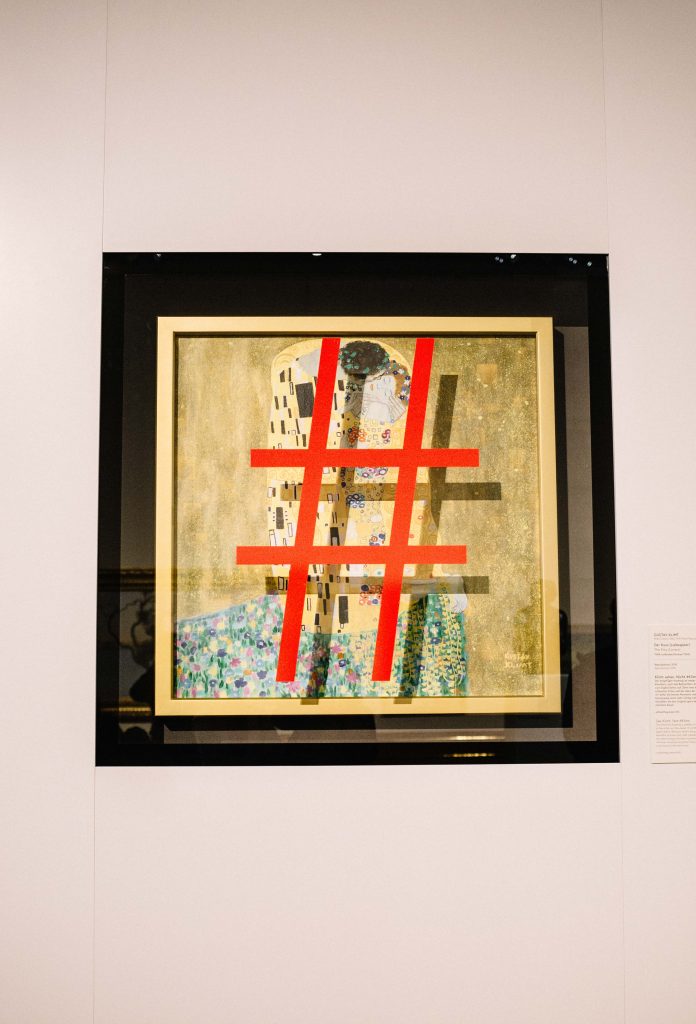
Stepping back, we tried in vain to look beyond the hashtag – unable to catch a glimpse of the art work in its full glory. A wry smile forming across our guide’s face, he explained that this was the point of the artwork. It was a clever visual prompt to remind us that viewing life through a small glowing screen – one littered with hashtags – does indeed dull the experience. Watching as other visitors whipped out their phones to take an (unintentionally) ironic selfie next to the hashtag covered installation, our guide led us into the adjacent room where the real ‘The Kiss’ artwork was waiting.
Now incredibly conscious of how we viewed the towering painting, we scrutinised every detail of Klimt’s iconic piece. Taking the time to absorb every fleck of gold, ‘The Kiss’ came alive; new details appearing the longer we studied it. The bright red hashtag we saw beforehand only acted as a timely reminder that we should all put our phones down once in a while, in order to truly observe the world around us.
3) Memories are made stronger without social media
A little like my memory of that phone call home to my Grandma, exploring Vienna without the use of social media appears to have made my memories of it (unexpectedly) stronger and more vibrant.
I’m sure that by now, we’re all well-versed in the notion of ‘mindfulness’ – a technique that I’ve dipped in and out of over the last few years. Our trip to Vienna, however, was the first time I’ve truly experienced mindful travel. Without distracting bleeps, flashes or notification signs, my experience of Vienna was beautifully uninterrupted.
As I sit here typing, reflecting back on our trip from the comfort of my desk chair, my memories of Vienna are abundant. In fact, I probably have more memories of it than I do of our previous three or four trips combined. From the rich smell of coffee in the cosy coffee houses, to the feeling of warm breath on my hand from one of the city’s horses, I remember details that are often lost on my usual trips. Without any visual prompts, the map of the city also remains clear in my mind; the inevitable result of consciously manoeuvring ourselves around Vienna’s streets with just a physical map to hand. Often passively following those maps provided by our mobile phones – travelling offline, without the use of these robotic directions, enabled us to not only get to know the city better, but to commit it to memory.
4) Capture a moment, not perfection
Armed with just our LOMO instant camera, the Vienna Tourist Board had set us the challenge of capturing just 10 images over our three days in the city. Glancing at Laura as she unboxed the camera, I saw her face twitch with anxiety. Although capturing travel images and stories is something we’re well versed in doing, capturing just one image at a time is an alien concept to us both. “Just move your arm a little to the right,” or “jump a little higher for the boomerang,” is instead our comfort zone. Indeed, with the luxury of being able to re-take as many images as we wish on our phones or DSLR camera, our special travel ‘moments’ can, it seem, last hours.
The irony.
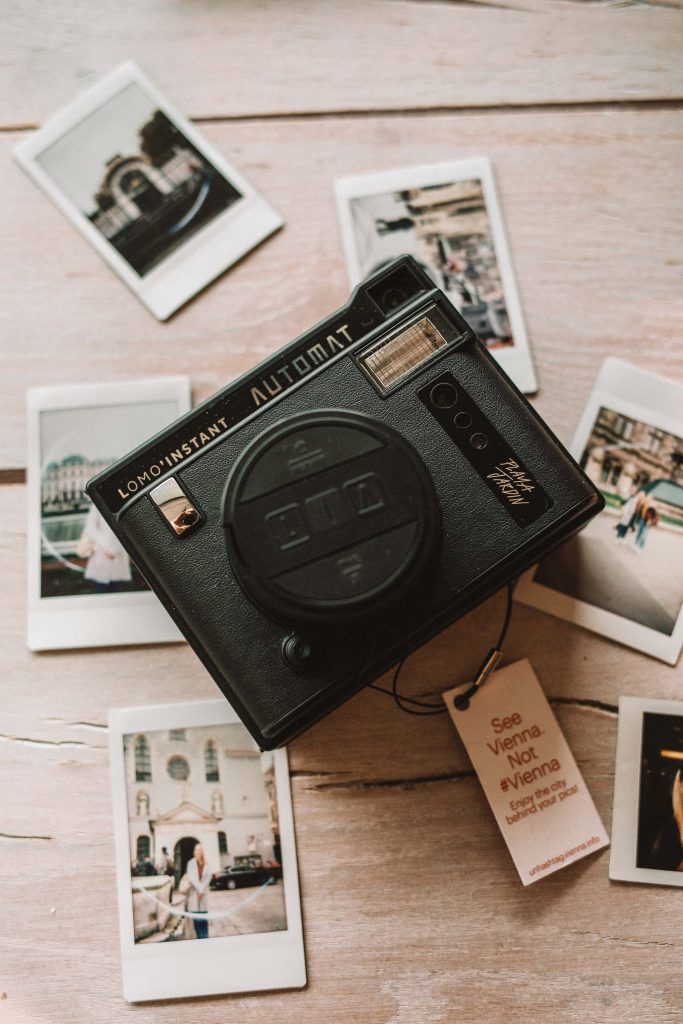
Clutching the instant camera, I nervously reached for the shiny button to take the photo. I had only one opportunity to capture this moment and I didn’t want to get it wrong. As Laura smiled down the lens from outside the city’s famous Opera House, there was a whir and a flash as my first instant photo popped out. It was all a little startling. Staring anxiously as we watched it slowly begin to develop, the long-forgotten anticipation of waiting to see the results of a photo crept back in. Slowly, Laura’s face appeared, along with a rogue pigeon that had decided to fly behind her at the moment the shiny button was pressed. Usually, this would require Laura to move back into position; a second attempt necessary. This time, however, we laughed and clutched the little photo closer; a unique travel moment captured forever.
The subsequent 9 photos taken over the course of our three days in Vienna followed suit. While some were a little out of focus, others captured me with my eyes closed. Indeed, none were perfect. Yet despite this, these 10 small memories felt strangely precious as we tucked them carefully into our coat pockets.
Looking back at the photos now, the captured moments seem more alive – more real, somehow. Furthermore, without the stress of continually re-shooting these images – the quest for the ‘perfect’ photo always eluding us – these small moments were far more enjoyable to capture.
5) Travel should be a personal experience
Finally, and perhaps most importantly, our time in Vienna reminded us of how much we enjoy travelling – but travelling in our way.
Over the years, travel is something that has become a little depersonalised; something completed for tourism boards or brands, rather than for ourselves. This often means that the attractions we visit whilst in a new country, or the places we choose to eat, are dictated by what will be validated on social media. Despite our love for art galleries and shadowy museums, while completing these sorts of campaigns, these locations are often off-limits: a photo too hard – too uninspiring – to capture for use on social media. As such, travel is something that’s become dictated by the preferences of others. Sadly, what images will do best on our Instagram feed is often one of our first thoughts when planning a trip.
The above statement is as toe-curling as it sounds, and something we had failed to truly consider before our Unhashtag Vienna Campaign. Without any need to document our travels on social media, our experience of Vienna felt more personal; more liberated. Free to decide where to visit, without the pressure to document it online, we headed for places in the city that we wouldn’t usually explore.
Entering the Wes Anderson Exhibition at the Kunsthistorisches Museum Vienna, I watched as Laura’s eyes lit up at the typically uniform rows of artefacts on display. Our bags tucked away in the Museum’s lockers, we roamed the exhibition completely unburdened by our usual camera straps or phones. Time melted away as we stood transfixed by the beautifully curated rooms, with no desire to share our experiences with anyone other than ourselves. My most memorable experience of the afternoon is when I chatted with a fellow visitor about the miniature mouse coffin that took centre stage at the exhibition. As small as an experience this might seem (as small as the mouse, I imagine), it’s one I’m sure I won’t forget: two strangers stood one rainy afternoon in Vienna, discussing a tiny, perfectly ornate, mouse’s coffin.
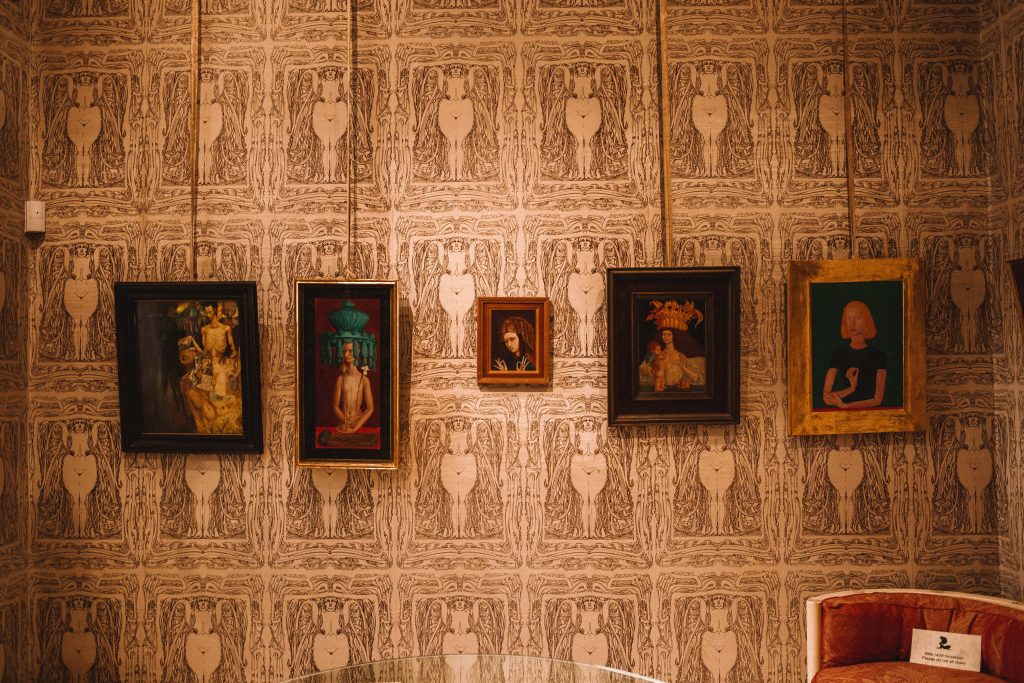
In a (bizarre) society where diligent queues form for selfies outside of the latest flower-covered cafe, it can be difficult to remember who it is you’re capturing an image or experience for. Our three days without social media, however, reminded us that ultimately, travel and its many experiences should be both completely personal and entirely subjective. Something visited out of love rather than due to social pressure. Indeed, you may have captured the perfect image of Vienna at sunset, but if it meant missing out on your favourite art exhibition, then does that image really mean anything?
For us, time spent offline reignited our love for travel and reminded us of our own interests and passions. It was a timely reminder that if we’re not pleasing ourselves in this online world, then who are we pleasing? And why should they take precedent over our own experiences?
In the future, we hope to travel ‘offline’ as much as we travel ‘online’. Allowing for the inevitable days of tweeting and posting, we’ll also be sure to carve out time when we can enjoy experiences away from our mobile phones. Indeed, if our trip to Vienna has taught us anything, it’s to ultimately enjoy and relish those experiences that can’t be captured; as that’s where the very best moments can be found.
Thank you to the Vienna Tourist Board for inviting us to take part in this special and wholly unique campaign.
Pin it:
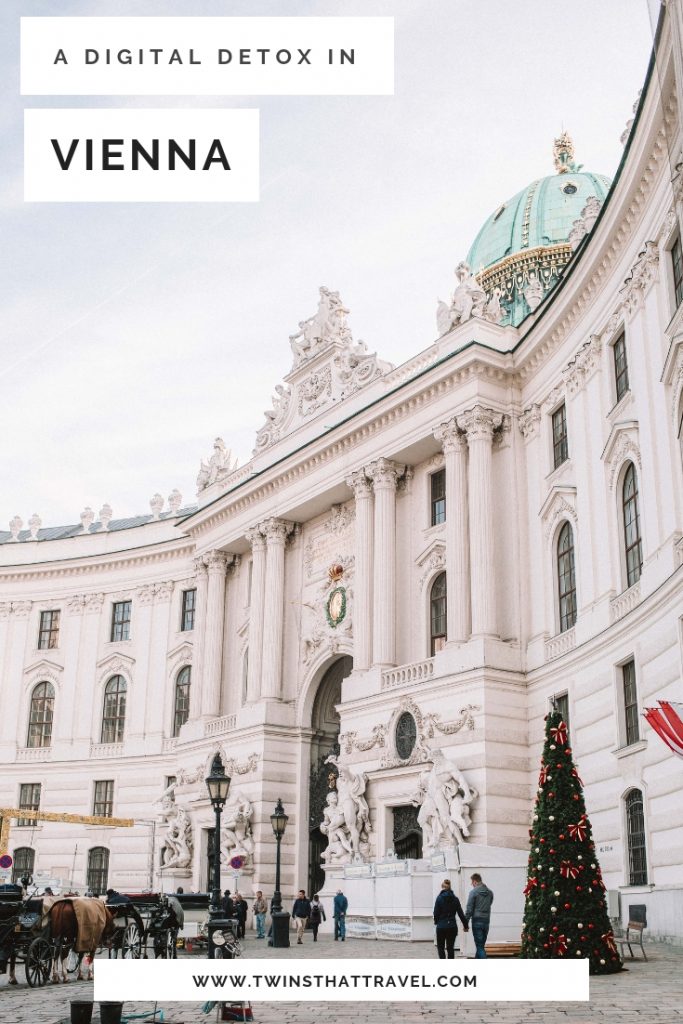

2 comments
What an original and incredible campaign! I love slow travel and it’s great to see how a tourism board is embracing this type of sightseeing without feeling like they should be madly promoting their city online.
Also, 3.-something hours on Instagram a day? What remarkable self-restraint; teach me your ways 😀
As soon as you announced your trip with this campaign I was looking forward to reading about it. I think it did me a world of good when I travelled around New Zealand as I didn’t buy a local sim card. Therefore any data I used was going to cost a fortune and quite often we were without WiFi for a few days. Sure I still took photos, and I still shared things online but nowhere near as often as I could have done Instead of seeing this as a wasted opportunity for my blog, it just gave me more of an opportunity to enjoy the incredible scenery around me and make memories that last. I was horrified to see almost a whole bus of people queue along a pier to all get the same shot of them jumping in the air at the end for Instagram, but were seemingly oblivious to their beautiful surroundings. I hope you manage to continue your offline travels as well as those you share!